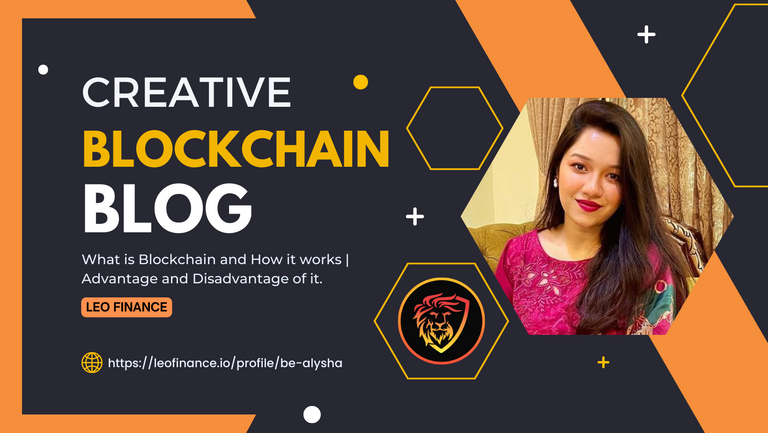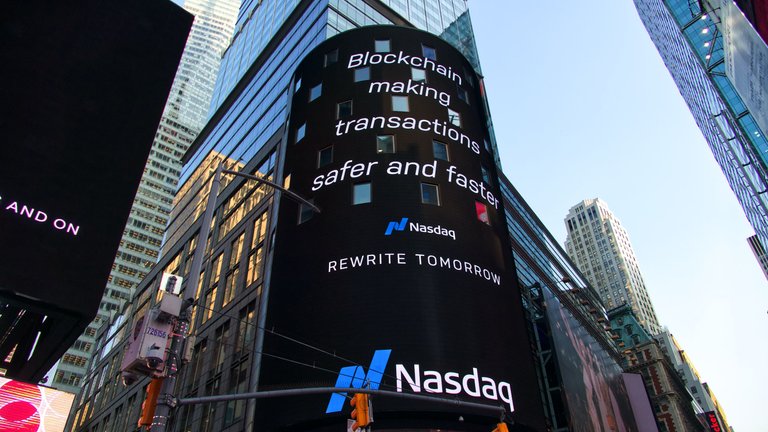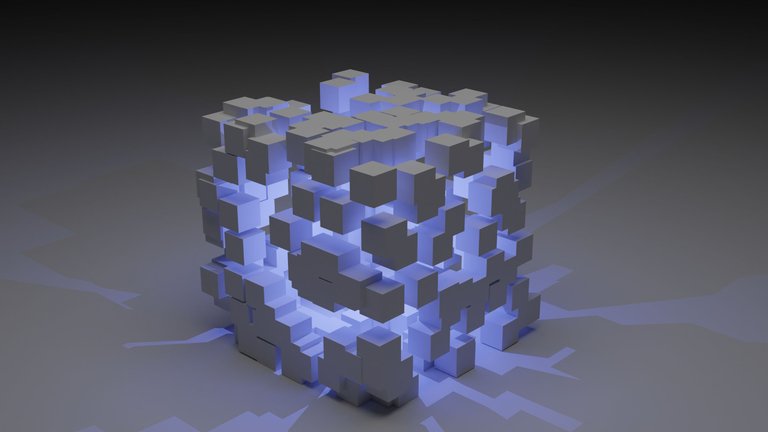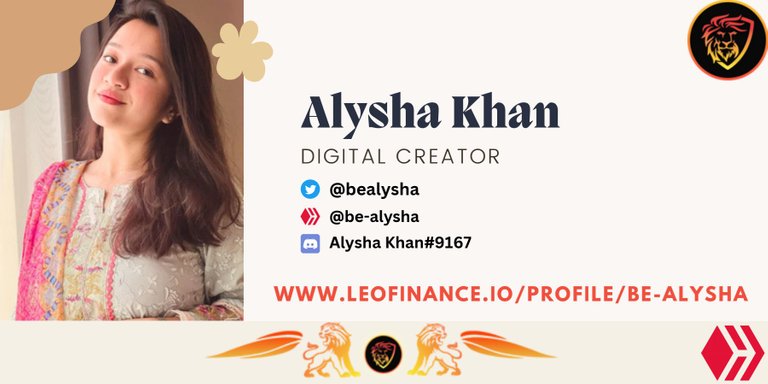What is Blockchain? How Does Blockchain Work? The Advantage and Disadvantage of Blockchain

Hello Everyone,
Today I am coming with my another Long Form posts on Leo Finance. Today I am going to make a detailed article about Blockchain and How it works as a submission of the Finance Bro Adventure on Zealy Adoption Campaign.
What is Blockchain
A Blockchain joins groups of financial transactions together in what are called blocks. These blocks result in a growing list of transactions that are linked together via cryptography. When a transaction is posted, it tells everyone that x amount of the currency was sent from Wallet A to Wallet B. All transactions that occur during that period of time are contained in an individual block. The data contained in each block, in addition to the transaction, is also a cryptographic hash along with a time stamp. With each new block created, it is linked to the previous one thus creating a "chain". After the blocks are fully validated and joined, they cannot be chained without the consensus of the block producers agreeing to reverse it.

Distributed Ledger Technology
Blockchain used Distributed Ledger Technology (DLT) to maintain a public ledger in a decentralized fashion. This is done through node operations who are unrelated all having an duplicate copy of the ledger on their computers. The different nodes all form a network. A blockchain ledger has no central authority. This means the block producers are the ones responsible for the continued expansion of the ledger. This has a major impact upon money. The present monetary system sees the banks entrusted with the responsibility for the global ledgers. All operations are done in a peer-to-peer manner. Without a centralized entity, the different nodes interact in a way that allows for the consensus model to be follower. A block producer, one awarded the block, will validate the transactions and update its ledger. After that, the update is broadcast to all the other nodes so they can be updated. The validators are incentivized to perform this service through rewards. Under blockchain systems, a certain amount of "paid" for each block that is added to the network. This will vary based upon the system and the inflation rate of the currency. What is paid out is cryptocurrency.
What is Cryptocurrency
Cryptocurrency is the monetary system that is built upon blockchain. It is the most discussed aspect of blockchain due to the pricing activity in the markets. Blockchain is the accounting system for cryptocurrency. The latter is a digital medium of exchange which has no physical counterpart. There are no banknotes or any other form of physical form. It exists solely in the virtual world. Cryptocurrency is built on top of blockchain. They two cannot be separated. Each transaction that affects wallets is posted to the blockchain. Since these are not only permissionless but also public, anyone can view the transaction through a block explorer. All this creates a digital medium of exchange. Whatever value is tied to a specific cryptocurrency, that can be transferred to another simply by sending it the appropriate wallet. This is where cryptocurrency performs many of the same functions as a savings bank. People are able to send, receive and store money simply using a digital wallet. Bitcoin is the best known cryptocurrency. It was introduced to the world by Satoshi Nakamoto, the anonymous developer. We also were introduced to the present concept of blockchain at the same time. Bitcoin uses the proof-of-work (PoW) consensus mechanism, something many have opposed due to the energy usage. Another popular blockchain is Ethereum, developed by Vitalik Buterin among others. This is now being converted to use the proof-of-stake (PoS) consensus. Ethereum introduced the world to smart contracts which is forming the foundation for many parts of the decentralized finance (DeFi) system.

What is Blockchain Access
Every blockchain, even if permissionless, does require some way to access it. This can come in a variety of forms. The most common is by having each user pay a transaction fee. This is a per transaction cost that allows one to interact with the network. Ultimately, this is paying the block producers for validation and adding the transaction to the ledger. Another way is through the use of an access token. This is either a token (or coin) that was developed for this purpose or has this feature incorporated into it. By holding the token the user has the ability to engage with the blockchain. For the first, this encompasses most like Bitcoin, Litecoin, Ethereum, and TRON. It is pretty standard for a blockchain to have transactions fees. The second option is actually much rarer, at least to this point. An example of an access token is Hive Power. This is on the Hive blockchain and by staking the base layer coin, $HIVE, on receives the ability to interact with the network.
What is Micropayments
Blockchain introduces an interesting concept. It brings to the table the idea of micropayments. This is transactions that are fractional units of currency. Since it is difficult to break down fiat currency into smaller units than a penny or pence, micropayments becomes impossible. At the same time, the networks that are used have too high a cost to utilize these. When it comes to the banks and other money transmitters, the transaction fees simply get in the way. Even with most blockchains, this is an issue. Anytime there are transaction fees, even at a cent or two, this makes micropayments impossible. The cost of transfer is higher than what is being sent. One blockchain that could make an entry into this arena is Hive. The fact that it is a feeless blockchain means that micropayments can take place. While still new, people are going to have to experiment and innovate. This means we could see social media and things such as royalty payments radically altered.
Advantage of Blockchain
Immutability : Blockchain supports immutability, meaning it is impossible to erase or replace recorded data. Therefore, the blockchain prevents data tampering within the network. Traditional data do not exhibit immutability. The conventional database uses CRUD (create, read, update and delete) at the primary level to ensure proper application operation, and the CRUD model enables easy erasing and replacing of data. Such data can be prone to manipulation by rogue administrators or third-party hacks.
Transparency : Blockchain is decentralized, meaning any network member can verify data recorded into the blockchain. Therefore, the public can trust the network. On the other hand, a traditional database is centralized and does not support transparency. Users cannot verify information whenever they want, and the administration makes a selected set of data public. Still, however, individuals cannot verify the data.
Censorship : Blockchain technology is free from censorship since it does not have control of any single party. Therefore, no single authority (including governments can interrupt the operation of the network. Meanwhile, traditional databases have central authorities regulating the operation of the network, and the authority can exercise censorship. For instance, banks can suspend users' accounts.
Traceability: Blockchain creates an irreversible audit trail, allowing easy tracing of changes on the network. The traditional database is neither transparent nor immutable; hence, no permanent trail is guaranteed.
Disadvantages Of Blockchain
- Speed and performance : Blockchain is considerably slower than the traditional database because blockchain technology carries out more operations. First, it performs signature verification, which involves signing transactions cryptographically. Blockchain also relies on a consensus mechanism to validate transactions. Some consensus mechanisms, such as proof of work, have a low transaction throughput. Finally, there is redundancy, where the network requires each node to play a crucial role in verifying and storing each transaction.
- High implementation cost : Blockchain is costlier compared to a traditional database. Additionally, businesses need proper planning and execution to integrate blockchain into their process.
- Data modification : Blockchain technology does not allow easy modification of data once recorded, and it requires rewriting the codes in all of the blocks, which is time-consuming and expensive. The downside of this feature is that it is hard to correct a mistake or make any necessary adjustments. One solution doesn't fit all requirements, and this is the same with blockchain technology. There is a lot of buzz in the industry about blockchain and Web3, and many organizations are looking to move from Web 2.0 to Web3, but this is not a straightforward "lift-and-shift" type of solution. Organizations should do their due diligence and conduct a deep dive analysis to see if the blockchain technology fits their needs and then plan the development or migration to Web3 accordingly.

So with that I conclude my article. I hope you can get to know about LeoVerse and the projects based on Leo Finance, How it works in the Crypto sector from the post. If you want to know more about Leo Finance, $LEO or something related then definitely let me know in the comment box. I will try to answer your questions. I linked some keywords to Leo Glossary. You can click them out to know the definition to concepts of the keyword. It's nice to use them in my article.

Visit my Leo Finance profile to read my various kinds of articles. Also there are some of my makeup vlogs, you can watch them through 3Speak if you want. If you want me to write on any topic then let me know. I will try to gain knowledge about it and give you some good ideas through my articles. Join @theterminal discord server to get the perfect answer of your questions about Hive, Cryptocurrency and Discord. They aim to help folks learn the etiquette and workings of the Blockchain, grow the user's account and find the communities where the content creators can thrive.
- Join Leo Finance Discord Server
- Join The Terminal Discord Server
- Leo Finance Adoption Campaign Announcement
- Join The Adoption Campaign on Zealy
- Visit my Leo Finance Profile

Thumbnail created with Canva. Footer created with Canva. Page divider made by @barge. Other assets from Leo Finance website and Discord server. All content is mine unless otherwise stated


Posted Using LeoFinance Alpha